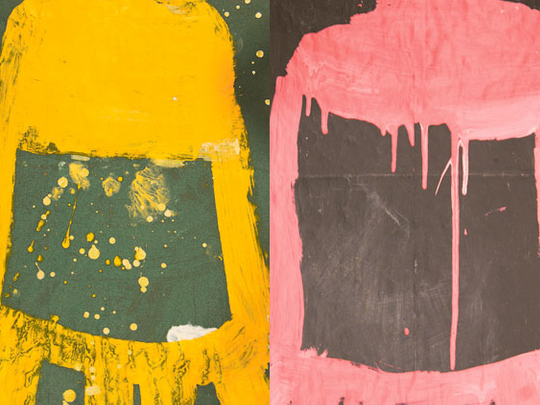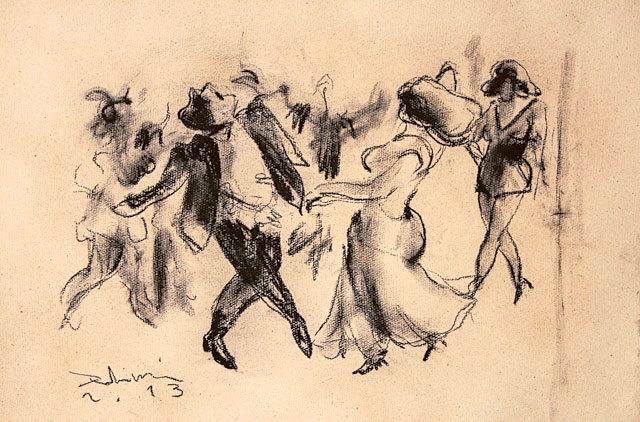
American artist Gary Komarin’s solo exhibition in Dubai, “The Road to Dialoro”, features recent works, including new works from his iconic series “Cakes”. The playful expressionist paintings speak about the childlike wonder with which he explores his inner and outer world. The show offers insights into the work of an artist, who has won many prestigious awards — including the Joan Mitchell Prize in Painting — and has exhibited his work alongside famous artists such as Andy Warhol, Francis Bacon and Jean-Michel Basquiat.
Komarin’s style of blending colour field painting with drawings has been influenced by his mentor, Philip Guston, who was a pioneer of Neo-expressionism. The unique look of his paintings comes from the fact that he uses industrial canvas tarp and drop cloths, which he paints with a quick-drying concoction of latex house paints diluted with spackle and water. While working on the paintings, he lays the untreated tarps on the floor and paints from all directions, deliberately avoiding any sense of orientation. And he integrates the drips and spills as well as the folds on the tarp in his compositions.
The paintings appear childlike and simplistic. Layers of colour are interspersed with whimsical crayon and charcoal drawings of cakes, bottles, lopsided vessels, Mickey Mouse ears and abstract shapes. And every action as he creates and erases drawings or patches of colour in the different layers is visible. But despite the playfulness, spontaneity and transparency of his paintings, there is clearly an element of deliberation in the abstraction and the interplay of line, colour, light and movement in the compositions. The absence of any narrative forms that are vaguely familiar, but resist recognition, and large empty patches of colour in the paintings compel viewers to delve deeper to understand them.
“Children see the world as beautiful. But as adults we lose the ability to see beauty in the most commonplace objects or occurrences. I try to revert to a preconsciousness that comes so naturally in childhood. I see my paintings as pre-linguistic pieces where forms travel and commingle through time and space, free from the tyranny of order and reason,” he says.
Even the enigmatic titles of his paintings are randomly pulled out from a box in which he collects names of people, places, words from different languages and bits of poetry or conversations that catch his attention. For instance, “Loosha in Blue” comes from the name of one of his children’s babysitters, and is inspired not by the person, but by the musical quality of her name, Loosha. And “Rue Madame” is the name of a street in Paris, which the artist uses often because of the different ways it can be construed. “I try to match the title with the painting, but I do not want people to hunt for meanings in my paintings based on the titles,” he says.
The recurrent forms in Komarin’s work come intuitively from his memories, experiences and surroundings. The bottle-like shapes refer to his early still-life paintings and to the work of Giorgio Morandi; the patches of opaque blues recall the lake where he went fishing with his father and his fear of the deep waters; the watery greens represent the beautiful countryside around his current home in Connecticut; and the warm yellows and oranges are inspired by his memories of Spain.
A favourite motif of the artist is cakes. Often he draws a stack of cakes that looks like an architectural drawing. This is a reference to his mother, who loved baking and to his father, who was an architect. For this show, Komarin has created a series of cake paintings on recycled paper bags. “I am intrigued by the way the bags fold back into a flat object after being so volumetric when open. They provide a terrific surface for painting and I like their puffy physicality after the enamel paint is applied,” he says. But the artist maintains that the images in his paintings mean nothing. “Every viewer has different associations with these images and will read them differently,” he says.
Jyoti Kalsi is an arts enthusiast based in Dubai.
The Road to Dialoro will run at Cuadro Gallery, DIFC until June 19
Box:
Tehran-based artist Mohammad Rahimi’s latest body of work, “Once Upon a Time” is a series of mixed media paintings and ink sketches depicting a group of people dancing. The men, dressed in black coats and hats, have thick moustaches and are seen dancing with abandon. The women, dressed in fashionable dresses, participate in the festivities with equal vigour. Iranians, especially from the older generation will instantly recognize that the men in hats are doing the “Baba Karam”, a joyful dance popular in the old days.
“I grew up in post-revolution Iran and have only seen such celebrations in old movies and photographs. I also have childhood memories of seeing my grandfather doing this dance for us, dressed in the traditional black coat and hat. These nostalgic scenes and the bright colours in my paintings recall an era when Iranians were happy and free to dress and live the way they wanted. But, this series is also about connecting with the past, and with the values, traditions and strong sense of community that are being lost due to urbanisation, globalisation and the fast pace of modern life,” Rahimi says.
“Once Upon a Time” will run at Etemad gallery, Al Quoz until June 28.












